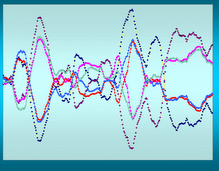GE printed three cross overs in the past three months - one was profitable, one wasn't and one was a break even.

Cross over 1 (X-over 1) was almost an instant failure. I don't like buying into a gap down that continues down as happened on 2/15. I would have passed this cross over as should you.
Cross over 2 (X-over 2) became profitable but then collapsed. That hanging man on 3/26 indicates an exit. This trade would have been break even at best.
The third cross over returned about 4.7% in 6 days (4/26 - 5/2). This is the kind of cross over that we are looking for constantly.
Finding cross overs is simple - you don't need any fancy software nor do you need any money involved. Just time. I hope that the readers of this BLog are familiar with
stockcharts.com . If you are, good - if not - you should remedy that fault immediately.
Select a candle glance group and click on any of the charts in the group. Then click on the top most chart that appears from that entry. This leads you to sharp charts 2. The Stockcharts sharp charts 2 capability permits you to change everything from number of days, weeks, or months to types of moving averages to types of indicators. and then simply run a set of stocks through that chart looking for cross overs. It is tedious but the exercise does your mind a world of good and you might pick up on a lot of other potential entry conditions as well. And if you hit a great cross over such as ATVI you will be well paid for your efforts.

Again there are three cross overs shown on this chart. Number 1 is a gap up and while gap ups sometimes go on to higher and higher places most often they are an overreaction to some news event and sobriety soon hits the market place and they fail. This was that kind of gap up.
Number 2 was a bit better and actually gave you a piece of change before it failed at the end of February. But that failure was not a result of the stock but a result of the market (Feb 27th) so this would have been a good one to watch.
And sure enough number 3 came along and took ATVI to the sky. The tweezer top defines the sky in this instance and suggests a perfect time to take profits and exit the trade.
Really sharp readers will note that
Philip's Set up is associated with each of these cross overs. And I just noticed that myself so it might be a good thing to look for as well. It won't occur with every cross over but when it does it might signify something special in the stock.
Our final exhibit is in the class of failed cross overs. Here is MOT

First - it's MOT. MOT is in the news all the time and the words - "failing company", "bad stock", "poor investment" are usually found in the article. But the reason why you shouldn't take this one is the same as discussed above on GE - there is a gap down open. And that cross following the cross over probably suggests caution. But even if you did take it and then had it gap down again on you the next day you could be assured that it would come back a bit because it is MOT and regardless of my feelings about the stock it is beloved by the funds. So your max loss might have been around 30 cents a share and that's not too bad.
The cross over method will yeild a lot of winners but you have to watch the entry and make sure that the stock wants to go up and isn't just fooling around.
Find the code for stockfetcher
here.
And again - if anyone finds a consistent method to better this approach please share it with all of us. Thank you.
















